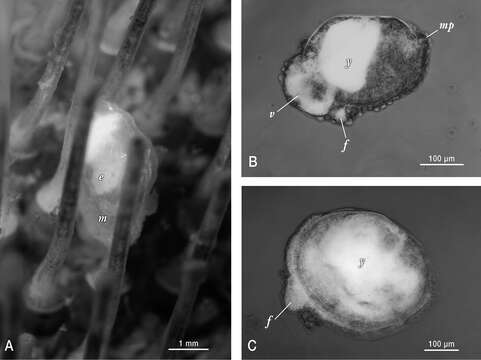Plancia ëd unclassified Bivalvia

Descrission:
Figure 2.Photographs of live Waldo arthuri material sampled in Barkeley Sound in 1989. A Brooding adult attached to its host. Note the papillated mantle (m) that is partially retracted and the presence of ~ 200 µm diameter white yolky early embryos (e) in its ctenidia, visible through the transparent shell B Micrograph of mid-late development embryo (equivalent to the pediveliger stage in pelagic developing bivalves) that was dissected from its brooding parent’s ctenidia. Labels indicate protruding foot (f), modified non-ciliated velum (v) with partially consumed yolk reserves (white areas) and mantle papillae (mp) in addition to a dense mass of yolk (y) sequestered in the anterior shelled half of the embryo C Micrograph of smallest/youngest (20 µm of dissoconch growth) specimen observed attached to an urchin host. Note the protruding foot (f) and the apparent presence of persistent yolk reserves (y) dispersed throughout much of the juvenile’s visceral mass.
Ancludù an coste pàgine-sì:
- Life
- Cellular
- Eukaryota
- Opisthokonta
- Metazoa
- Bilateria
- Protostomia
- Spiralia
- Mollusca
- Bivalvia
- unclassified Bivalvia
- Galeommatoidea
- Lasaeidae
- Waldo
- Waldo arthuri
Costa plancia a compariss an gnun-e colession.
Anformassion an sla sorgiss
- licensa
- cc-by-3.0
- drit d'autor
- Paul Valentich-Scott, Diarmaid Ó Foighil, Jingchun Li
- sitassion bibliogràfica
- Valentich-Scott P, Ó Foighil D, Li J (2013) Where’s Waldo? A new commensal species, Waldo arthuri (Mollusca, Bivalvia, Galeommatidae), from the Northeastern Pacific Ocean ZooKeys 316: 67–80
- original
- archivi ëd mojen original
- visité la sorgiss
- sit compagn
- Zookeys
- ID


